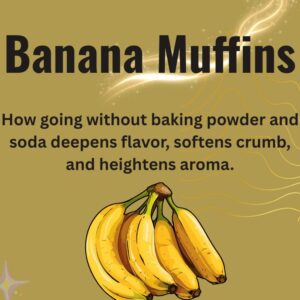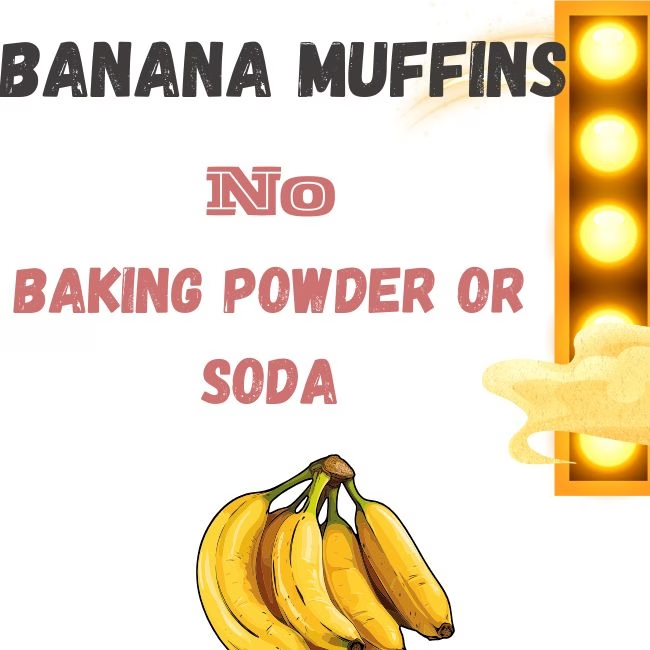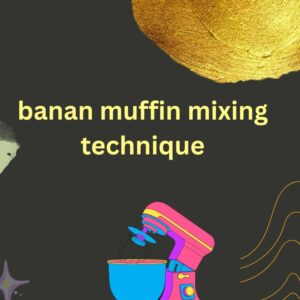banana muffins without baking soda or powder : Basic Batter
I’m a self-confessed Baking Nerd, so believe me when I say I’ve tried every variable to perfect that comforting banana hug. My latest obsession? Banana muffins without baking powder or soda. I got back and forth on whether it would even work, but after countless experiments and ingredient adjustments, I finally cracked the code! The resulting texture is NOT just light and airy; it’s magically dense yet tender, which allows that pure, deep banana flavor to shine like never before. And the aroma that fills the kitchen? It’s simply perfect. Trust me, these are the BEST if you want the most intense, unadulterated banana experience. Done!
Why And How No Baking Soda Or Powder Boost Banana Muffins Flavor

I’m predictable. My absolute go-to snack, if I have time, is a muffin that’s so intensely flavored, you don’t even need a glaze.
When you add baking soda (a base), you instantly start neutralizing the good stuff—the natural acidity—in your perfectly ripe bananas (they’re sitting around pH∼5.0). This chemical shift fundamentally alters the flavor molecules. It’s a fact: a more alkaline batter enhances those toffee, browned-sugar undertones. That’s why a lot of banana bread tastes like… well, baked sugar and cinnamon, not vibrant banana.
But without leaveners? The natural banana acids (like malic and citric) are allowed to shine! These acids actually stabilize and intensify the fruity compounds—the isoamyl acetate that gives banana its distinct scent and the ethyl butyrate that smells almost pineapple-y.
The result is unbelievable: a purer, cleaner banana flavor, free from that subtle metallic or “soapy” tone you sometimes get with too much soda. My first bite of these? It tasted like I was eating a slightly cooked, caramelized banana right off the bunch.
The Secret to That Incredible, Lingering Aroma
I think a lot of people underestimate how quickly we lose those beautiful smells in the oven. Bananas have over 250 aroma compounds, and they are incredibly delicate.
When you get that big, quick rise from chemical leavening, you’re creating tons of CO2 gas. This rapid venting is essentially an express train for all those wonderful, volatile aroma molecules right out of your muffin!
Without them, the batter’s structure stays tighter. There’s less of that “venting,” so those fruity aldehydes and esters are trapped longer. When you pull these out of the oven, the smell isn’t just “baked goods”—it’s a deep, warm banana perfume that lingers. It’s the difference between a synthetic banana candy and the scent of freshly mashed, perfectly ripe fruit.
Texture: Custard, Not Cake
I want something dense, moist, and almost fudge-like.
Leavening gases create air pockets that allow moisture to escape easily, resulting in a drier crumb. By omitting the soda and powder, we significantly improve moisture retention. The structure isn’t built on CO2
lift; it’s built on protein coagulation and the starches in the banana itself.
Bananas are nature’s perfect binder—full of moisture-holding pectins and fibers. When you don’t break that structure up with aggressive bubbles, these polysaccharides stay intact. You get a dense but incredibly silky, custard-like crumb that is genuinely melt-in-your-mouth. My husband thought I’d secretly blended cottage cheese into the batter; that’s how creamy they were!
How It Rises (It’s Magic, I Tell You)
“But how does it rise, you Baking Nerd?” you ask. Excellent question! It’s all about physics, baby.
Egg Power: When you cream the eggs and sugar properly, you incorporate micro air bubbles that act as natural “balloons.” These expand in the heat, giving a gentle, even lift.
Steam Leavening: Ripe bananas are 75% water! All that moisture, combined with the butter/oil, creates tons of internal steam when heated. This steam expands, creating tiny, fine-grained pockets.
The final product isn’t a massive, overhanging dome (which often collapses or tunnels, anyway). It’s a low, velvety crown with a perfectly cohesive, uniform, and dense texture. This also means they stay tender for days—they resist drying out because that dense structure locks the moisture inside.
I’m telling you, this is the way to do it. You end up with muffins that feel like a banana custard inside a tender shell. Done!
How To Choose The Best Flour When Skipping Baking Soda or Powder

This whole banana muffin debate? You know what? It’s kind of a big deal in my kitchen. I get it; we all have that emergency moment when we reach for the all-purpose flour. And honestly? It works! You’ll get a perfectly good, comforting, and familiar muffin. I won’t lie, I’ve done it countless times myself when I just need a quick fix before the school run. They do the job, and there’s absolutely no shame in that!
But then… there’s the other side of the coin.
I’ve been on a mission, a true obsession really, to perfect the banana flour muffin. When I first started working with it, my heart sank. The first batch was dense, a little dry, and frankly, just sad. I almost gave up, thinking, “Maybe this super-flour isn’t worth the hype.” But I’m a baking nerd, and I just couldn’t let it go. Banana flour is just SUPERIOR; the flavor is deeper, the texture it can achieve is beyond anything all-purpose can deliver—it’s magically tender and packs such a nutritional punch.
Texture:
This is where the magic happens, folks. Banana flour doesn’t need gluten to create structure. It’s built differently.
Early Setting:
Its unique starch gelatinizes way earlier than wheat starch. That means the muffin structure sets and stabilizes before all the steam rushes out. No collapse!
Tender for Life: Since there’s no gluten matrix, you’ll NEVER get a tough, rubbery muffin. It stays tender, always.
Moisture Magnet:
Thanks to its high resistant starch, it sips up moisture like a sponge, keeping everything soft and creamy instead of dense and doughy.
In short? Banana flour naturally creates a stable, custardy structure. No chemical help required. DONE!
flavor
You know what else I love about banana flour here? The flavor is just superior.
I was once testing a batch where I forgot the baking soda (yes, I do forget things, I’m a human, not a robot!). The muffins were bland, muted, and tasted faintly of dust. That’s AP flour for you—it brings nothing to the party and can actually mute the lovely banana essence if it dominates the ratio.
Banana flour, however, is a flavor superstar:
Natural Aroma: It’s already packed with those beautiful banana volatiles and a whisper of natural sweetness. Even without baking soda to activate them, you get a pure, bright, clean banana note.
Aroma Stay-Power: Its natural acidity keeps the good stuff—like those fragrant esters—stable under the heat. The banana scent lasts! You open the container and that incredible fragrance just hits you.
mouthfeel:
My final point, and maybe the most important: Mouthfeel.
I want a muffin that feels rich and soft, almost like a pudding. That’s the resistant starch at work! Because banana flour is absolutely packed with it, it holds water like nothing else and creates that wonderfully creamy, almost pudding-like texture, even when the muffin hasn’t risen much. It feels rich and soft naturally, without chemical puffiness.
So, when you want that gorgeous, stable, tender, perfectly banana-fragrant muffin without the chemical lift? Banana flour is the only answer. Go on, get baking! You’ll thank me later.
Simple Adjustment When Working With Banana Flour:
The truth is, you CAN’T treat it like regular flour. My notebooks are full of crossed-out ratios, scribbled notes, and flour-dusted math. I’ve baked so many dry muffins in the pursuit of perfection, my family staged an intervention! But I finally cracked the code, and I want to save you the heartache.
Here is the EXACT blueprint I now swear by—the adjustments that turn a sad, dense hockey puck into the BEST banana flour muffin you’ve ever had:
Liquid , eggs ,
liquid : You’ve got to be generous here. Increase it by 10–15%. Think of banana flour as a very thirsty ingredient; it soaks up moisture like a sponge, and if you don’t compensate, you’re headed for a dry crumb. More liquid equals a beautiful, smooth batter.
Eggs: This is a crucial one for lift! I always add 1 extra egg (or 2 extra yolks) for every 12-muffin batch. Those egg proteins are your little secret agents for trapping air and giving you that gorgeous rise and stability.
fat, sweetener:
Fat (butter, oil, or yogurt): Time to be a little decadent. Slightly increase your fat by 5–10%. That little boost of fat is what keeps the muffins tender and stops them from getting too dry. It slows down the starch doing its thing, which means a softer texture, always.
Sweetener: Ditch the plain granulated sugar for this one. Use brown sugar, coconut sugar, or honey. These types of sweeteners are key because they hold onto moisture better, and they help those banana notes caramelize beautifully.
Resting Time:
Don’t skip this! Let the batter rest for 10–15 minutes before baking. I know, the oven is calling your name, but this time-out lets the starches fully hydrate. It prevents gumminess and ensures you get the maximum, even rise.
Try these adjustments. You’ll be amazed at the difference. Now, don’t you think those perfect banana muffins are calling your name?
Great Mixing Techniques For Perfect TEXTURE
Look, let’s be honest. Getting a truly tender, perfectly domed muffin—especially when you’ve thrown out the leaveners—is pure wizardry. Done wrong, you end up with a dense, pasty hockey puck. And we don’t want that!
I’ve been down this road. Years ago, I was completely obsessed with creating a naturally lofty muffin using only what nature gave me. I mean, I had a spectacular fail on a rainy Tuesday that my kids still talk about—it was flat, rubbery, and a genuinely sad affair. Excellent emergency cupcakes, though, are not a sad affair!
The Secret Weapon: How We Trap the Magic
Do I hear a challenge? Because here’s the deal: without baking powder or soda to pump things up, your crumb is 100% dependent on four absolute essentials. You gotta be a precision artist here.
- Mechanical Aeration: Hello, Air!
This is where the elbow grease comes in. We whip the living daylights out of those eggs, creating a beautiful, stable foam. We’re not just mixing; we’re actively trapping air—tons of it! This is the only lift we’ll get, so don’t skimp on the volume.
- Stable Emulsification: Oil and Yolks Working Together
Listen, you need a stable home for that air. Getting your oil and yolks—those gorgeous, fat-laden heroes—to emulsify properly is key. This creates a velvet-smooth mixture that coats the starch molecules perfectly, controlling the moisture, and ensuring a sinfully decadent mouthfeel.
- Controlled Hydration: Taming the Banana Flour
Banana flour is a tricky beast, and we need to make sure the starch hydrates just right. Too much, too fast, and everything gets gloppy. We need to manage that water carefully so that when the heat hits, the starch can gelatinize beautifully—creating that magically soft and moist crumb.
- Temperature & Timing: The Final Set
It all comes down to the oven. We need that perfect moment where the egg proteins coagulate and the starch fully sets the crumb. This is how you get a muffin that holds its shape, boasts that natural dome, and is NOT dense on the bottom.
This is the science of the perfect bite. If you go wrong on any of these—if you overmix and deflate that precious air, or if your ingredients are unevenly mixed—you’ll crash the whole operation. Done!
Trust me on this: get these four steps right, and you’ll have the BEST banana muffin of your life. It’s a game-changer.
The Meringue Mastery:
Now for the ULTIMATE secret weapon: the egg whites! You need a bowl so clean, you could eat off it. I always give mine a quick wipe with lemon juice—it’s a little baking nerd trick to make sure the bowl is absolutely grease-free for the best whip.
Beat the five egg whites on medium speed until they’re foamy. Give it a minute. Then, start adding the remaining sugar (20g) gradually before cranking the speed to high. You’re looking for stiff, glossy peaks—when you lift the whisk, the whites should hold a sharp, pristine point, but they should not look dry or separated. Overwhipped meringue turns grainy, and we are NOT having that. That little bit of lemon juice you added earlier? That’s what stabilizes this foam, keeping all that precious volume locked in.Oh, I know that trick! Skipping the leaveners in banana muffins? It’s genius. The resulting texture is a tender, melt-in-your-mouth custard—NOT cakey. It concentrates the flavor, too; every bite is pure, deeply caramelized banana. An absolute indulgence!

Banana muffins without baking powder or soda
Ingredients
Equipment
Method
- Prep Like a Pro.You want that big, beautiful dome? Here's the KEY: crank your oven to 375℉(190 ℃) and pop the rack right in the center. This initial blast of high heat is a little trick—it creates a massive surge of steam from the egg whites, giving you that incredible oven spring. No sad, flat tops on my watch! Grab your tin and use the BEST paper liners you can find. I’ve had many a disaster trying to peel off a cheap liner, so don't skip this. And I mean it: all your ingredients must be at room temperature. Cold eggs are the enemy of a good whip; they just won't play nice.
- The Dry Mix Foundation.In a medium bowl, take your all-purpose flour, salt, and that genius freeze-dried banana powder (if you're being extra—and you should be!). Now, sift it. Yes, all of it. This isn't just to catch lumps; it's a non-negotiable step for aerating the flour. This action, this gentle fluffing, is what keeps your final muffin crumb tender without ever having to risk overmixing the gluten. Done!
- Grab your biggest bowl and the whisk attachment. We're going to create the heart of the batter. Beat those five glorious egg yolks with most of your sugar (80g) on medium speed. You need to go until they're pale, thick, and running off the whisk like a ribbon. This ribbon stage is where the magic happens: you're dissolving the sugar and injecting a ton of air. It should take about 3-4 minutes—seriously, don't rush this!Now, gradually stream in your oil while the mixer is running, then follow up with the vanilla and lemon juice. Finally, grab your mashed bananas, plus those lovely diced chunks. Get a spatula and gently fold them in by hand. I find the mixer tends to obliterate the chunks, and we want those pockets of banana goodness! The base should be perfectly smooth and emulsified. Excellent!
- The Gentle Fold: Dry into Wet.This is where your patience pays off. Take your dry mix and gently fold it into the yolk batter in three separate additions using your spatula. Think "cut and fold"—slice through the center, then fold over, rotating your bowl as you go. Stop the second everything is just combined. Listen: small lumps are fine! They are your insurance policy against a tough, chewy muffin. The batter will be thick, which is exactly what we want.
- The Meringue Mastery.Now for the ULTIMATE secret weapon: the egg whites! You need a bowl so clean, you could eat off it. I always give mine a quick wipe with lemon juice—it's a little baking nerd trick to make sure the bowl is absolutely grease-free for the best whip.Beat the five egg whites on medium speed until they're foamy. Give it a minute. Then, start adding the remaining sugar (20g) gradually before cranking the speed to high. You're looking for stiff, glossy peaks—when you lift the whisk, the whites should hold a sharp, pristine point, but they should not look dry or separated. Overwhipped meringue turns grainy, and we are NOT having that. That little bit of lemon juice you added earlier? That’s what stabilizes this foam, keeping all that precious volume locked in.

- Folding in the Air.This is the final, delicate move. First, lighten up the thick yolk batter by vigorously stirring in about one-third of your whipped whites. Don't be too gentle here; you're just softening the batter.Now, the remaining whites go in in two additions. Be gentle! Use that same "cut through and fold over" motion. Your mission is to keep as much of that glorious air as possible. Work quickly to prevent the structure from collapsing. The final batter should be light, voluminous, and totally streak-free. It's ready!
- BakeUse an ice cream scoop for even portions—it’s the simplest way to ensure uniform baking. Fill each liner to about ¾ full. Give the whole tin a gentle tap on the counter; this pops any large air bubbles that could leave massive holes.Into the 375℉ oven they go! Bake for 18-22 minutes, giving the tin a quick spin halfway through for even browning. They're done when the tops are a rich golden-brown, they spring back lightly to a gentle touch, and a toothpick comes out with a few moist crumbs. Don't overbake! Since we aren't using all banana flour, standard all-purpose will dry out fast, and that’s a tragedy.
- The Finish Line.Patience, my friend! Let them sit in the tin for 5 minutes—this sets their structure so they don't slump. Then, get them onto a wire rack. Cool them completely. If you leave them in the tin, the bottoms will get soggy, and a soggy muffin is a crime.Now, stand back and look at those magnificent, domed creations. You did it!

Leave a Reply